3. Opening and compiling a grammar
If you are in a hurry to hear "Turkish"
music you may jump to §5.2 because BP2 automatically compiles the alphabet
and grammar when prompted to produce items...
3.1 What's in the examples folder?
Folder "BP2 examples" contains
the following types of files:
- -gr.<name>
is a file containing a grammar (or several subgrammars,
see reference manual §4.4).
- -ho.<name>
is a file containing the names of sound-objects, i.e.
the terminal alphabet of a grammar, plus (if required) the information about
their possible homomorphic transformations (homomorphisms).
(See §2.4 or reference manual §4.1)
- -mi.<name>
is a file containing MIDI code defining sound-objects,
along with their metrical or topological properties (see §2.1 or reference
manual §3).
- -da.<name>
is a file containing (textual) productions of the
grammar (or any musically significant string of terminals/variables).
- -in.<name>
contains data relevant to real-time interactive control
(see §6).
- -se.<name>
is a file containing settings for a project (see §16).
- -kb.<name>
is a file containing a keyboard encoding (see §10.4).
- -wg.<name>
is a file containing rule weights (see §5.2, §5.4,
reference manual §4.6).
- -gl.<name>
is a file containing a glossary (see §7).
- -tb.<name>
is a file containing a time-base (see §3.6.3).
- -cs.<name>
is a file containing the description of Csound
instruments (see §17).
- or.<name>
is a file containing a MIDI orchestra (a set of patches
assigned to MIDI channels).
- + sc.<name> is a file
containing a script (see §8).
All these files are in 'TEXT' format but
they may have different file types to facilitate their
selection in BP2's load/save operations. These types are documented on-line:
click "Types-creators" in the "Frequently
Asked Questions" dialog.
BP2 files can be loaded directly in word
processors. Once the file has been edited save it as "ASCII" or "pure
text". Then retrieve it under BP2 using the "load any file"
option: type cmd-o with the option key down.
3.2 Headers and related files
Quit BP2 and double-click "-gr.koto3". This will automatically load the grammar and the
related "-ho.abc1" alphabet, for two reasons:
- The first line of grammar "-gr.koto3"
contains the name of its alphabet.
- "-ho.abc1" (or an
alias of it bearing the same name) was in the same folder as "-gr.koto3".
Here is a very important feature of BP2:
"projects" are made of several files linked together. This is a
modular approach since that the same file (e.g. "-ho.abc1") may be
shared by several projects. Whenever BP2 loads a file it scans its top lines
searching the names of related files. If related files are found they will be
loaded whenever necessary. For instance, the top of the grammar window for
project "-gr.koto3" indicates:
-or.koto3
-in.abc1
-tb.koto3
-se.koto3
-ho.abc1
i.e. the names of several related files.
(Their use will be explained later.) In turn, the "Alphabet" window,
in which "--ho.abc1" has been loaded, contains
the name of the sound-object prototype file "-mi.abc1"
required for its operation.
Generally you don't need to type or
modify headers. For instance, if the grammar contains no header, as soon as you
load an alphabet BP2 will insert a header with its name on tip of the "Grammar"
and "Data" windows. If you save the alphabet file under a different
name, or open another file, these headers are automatically updated accordingly.
If you delete the alphabet headerers are removed...
You can look at the different files
loaded: see menu "Windows" and try to remember keyboard shortcuts. As
usual with Macintosh® software, BP2 keeps a trace of changes and prompts you
to save or discard them before you clear a window or exit the program. However,
it has a non-standard an altogether safe feature: the first time you type cmd-s
after making changes, it prompts you to confirm the name and location of the
file.
Closing a window with text or graphic
data does not clear its content, except for the "Trace" window. It is
sometimes useful to simplify the screen display. Systems above 7.5.1 also make
it possible to reduce windows to their drag regions: a double or triple click on
the title bar does the job.
3.3 Organising projects
It is important to store related files
or their aliases
in the same folder so that BP2 finds them immediately. Reserve a special
folder to BP2 software, on-line documentation and start-up/shutdown files, as
shown Fig.8.
 Fig.8 The software folder
Fig.8 The software folder
MacOS offers an elegant solution for
arranging projects: use
aliases instead of moving or duplicating files. You may reserve another
folder for the
basic elements
: alphabets, sound-object prototype files, glossaries, etc., as shown Fig.9.
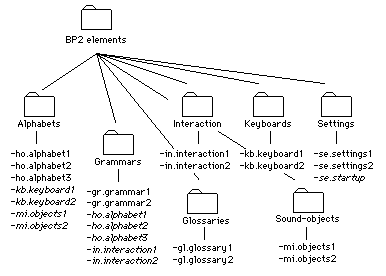 Fig.9 The folder containing basic elements
Fig.9 The folder containing basic elements
File names are just indicative and
should in general be more explicit. Names in italics are
aliases. Here, for instance, an alias "-
ho.alphabet1" is required in the same folder as "-gr.grammar1"
because the name of this alphabet file appears on top of the grammar file.
Similarly, other aliases have been placed near the files calling them. An alias
of "-se.startup" is needed in the "Settings" folder so that
scripts will execute the "New project" instruction properly.
Note that aliases for BP2 must bear
exactly the names by which the files are called when BP2 reads headers. Here we
used the same names for aliases and original files, the only way to distinguish
them being the italic.
It is advisable to create a separate
folder for saving your current work, given that whenever you create new basic
elements you will continue storing them in the folders shown Fig.9. A typical
example of work folder is shown Fig.10.
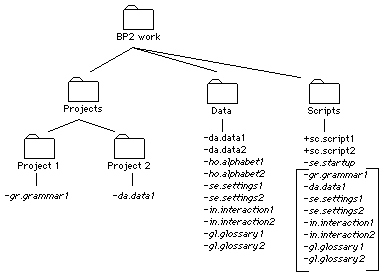 Fig.10 A folder for current BP work
Fig.10 A folder for current BP work
Here, Project 1 deals with a grammar
(and associated alphabet, etc., files that are automatically loaded), while
Project 2 uses only a data file (and associated files). Data files "-da.data1"
and "-da.data2" call alphabet, settings, glossary and interactive
file, aliases of which have been placed into the "Data" folder.
Some aliases in the "Scripts"
folder are shown between brackets because they are only needed if a script calls
them directly. Besides, scripts are capable of recording directory and volume
changes (see §8).
Data on the demonstration disk is not
organised in the rational way explained above, because aliases loose track of
their original files if both are moved to a different volume.
3.4 Network operation
Since BP2 is able to resolve aliases and
load files on remote volumes, this type of organisation may be extended to local
network configurations: the basic elements could for instance be stored on a
server and accessed by users with the usual read/write permissions. For
instance, it is safe to protect alphabets or sound-objects from unauthorised
modifications if they are shared by different projects.
BP2 can read directly text files edited
by DOS or Windows editors. In this process, "high
ASCII" characters are automatically transcoded. This feature has been
implemented to facilitate the direct interpretation of text-oriented musical
items or grammars produced in the Wintel environment.
3.5 A very simple grammar
Quit BP2 and double-click "-gr.doeslittle" in the "BP2 examples" folder. This will
start again BP2, bypassing the welcome dialog, and the content of the "Grammar"
window will be displayed as follows :
-se.doeslittle
// A very simple grammar that
does almost nothing
RND
S --> C4.C5.D5 C5 F#4.A4.C5
S --> G3 C4_ B3 C4
S --> {C5 D5 E5 F5, G5 D5
C6}
Type cmd-k or select "Compile"
in the "Action" menu. BP2 quickly compiles the grammar, i.e. it
generates some internal code (
tokens) that will enable it to produce items.
Now type cmd-r ("run") or
select "Produce items" in the "Action" menu. After a short
while an item is displayed in the graphic score and played on the MIDI output.
You are given the option to produce more, play again, display as text or cancel.
When producing more you will notice that the inference engine (the machines
that "runs" the grammar) selects any of the three rules in the grammar
to produce an item. This selection is random with equal probabilities, as
stated by the instruction "RND" on top of the grammar.
The operation of this grammar is very
simple : it starts with a
work string containing only 'S', the
starting symbol. A rule is selected at random.
The selected rule replaces 'S', its left argument, with its right argument.
Then no change is possible any more ; the item is displayed and played.
Type cmd-option space or select "Settings"
in the "Windows" menu. A
"Settings" dialog in two parts is
displayed, along with three more option dialogs. These will be analysed in
greater detail (see Fig.24 in §5.2). These settings have been loaded
automatically from the file "-se.doeslittle" whose name appears on top
of the "Grammar" window. For the time being, just watch the checked
items : "Show graphics" forces graphic display, and "Use MIDI
in/out" allows items to be played on the MIDI device. You may for instance
check "Non-stop improvize" button and type
cmd-r again. Now BP2 produces items continuously. To stop the production, hold
the mouse button down and then click "STOP" when the red dialog
appears in the top-left corner.
Improvizing on a slow computer may look
deceiving because BP2 takes time to produce a new item and does not keep the
tempo. Check the
"Compute while playing" button to
allow BP2 to proceed with calculations and keep items ready to play in a queue.
If the grammar is not too complex, the tempo will be maintained. The drawback
is that when you click to stop the improvisation, items still in the queue may
continue playing. Clicking again will abort playing, but it may keep a note
hanging because its 'NoteOff' has not been received. Flush the output clicking
the
"MIDI PANIC" button on the "Control
Panel".
Every time the grammar is run it
produces exactly the same sequence of pieces. This is due to the fact that BP2
resets its inner random number generator unless the
"Allow randomize" button is checked on
the upper "Settings" dialog.
3.6 A more elaborated project
Type cmd-l or select "Load project"
in the "File" menu to load a project : you will be prompted to locate
a grammar, and related files will be automatically loaded. Before loading a
project, BP2 clears all project windows ; the same may be done by typing cmd-n
or selecting "New project" in the "File" menu.
Clearing the current project is a good
habit when you start a new job. If windows are not cleared they may still
contain headers causing unwanted files to be loaded.
Look carefully at the "-gr.koto3" grammar file. On top of it you read :
-or.koto3
-in.abc1
-tb.koto3
-se.koto3
-ho.abc1
These are the names of the
MIDI orchestra file, the
interactive file, the
time base file, the
settings file and the
alphabet file respectively. The file "-in.abc1"
will be used for controlling BP2 interactively from a MIDI keyboard or
controllers (see §6).
The "-se.koto3" settings file
has already been automatically loaded. If BP2 does not find its name in the "Grammar"
window it searches it in the "Data" window.
You can load
grammar and alphabet files separately by typing cmd-o or selecting "Open
file" in the "File menu" when the corresponding window is active.
This additionally enables you to load files of types different of BP2 types,
for example a grammar that has been edited in a word processor and saved as pure
text: type cmd-o with the 'option' key down.
The "-mi.abc1" file has not
been loaded so far. BP2 will open it only at the time it is needed.
3.7 Tokenised alphabet and grammar
If you type cmd-h with the 'option' key
down you have the option to display the alphabet in its "tokenised"
form. A tokenised alphabet/grammar/glossary is useful
to show whatever the compiler has been able to understand. It is displayed in a
multi-purpose window called the "Trace" window.
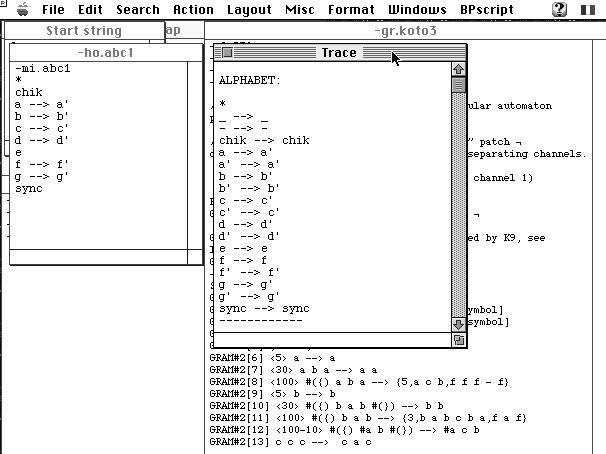 Fig.11 Tokenised alphabet in the "Trace"
window
Fig.11 Tokenised alphabet in the "Trace"
windowThe tokenised alphabet actually displays
the entire mapping of
homomorphism notated '
*' that was partly defined in the original alphabet (see §2.4).
Predefined symbols '-' and '_' represent
silences and
prolongations respectively. These are not
modified by any homomorphism. Other symbols are specific to this "-ho.abc1"
alphabet. Homomorphism '
*' changes 'a' to 'a'', but 'a'' remains unchanged. Symbol 'chik'
is also not affected by the transformation. (See §2.4 or reference manual §4.1
to understand homomorphisms.)
Looking carefully at the alphabet you
may notice that a new terminal symbol 'sync' has been appended: it was not in
the original file "-ho.abc1". The symbol was actually found between
single quotes in the grammar, and therefore appended at compile time.
Similarly, out-time sound-objects between angle brackets
<<>> may contain terminal symbols that BP2 creates at compile time.
The tokenised grammar is shown Fig.12.
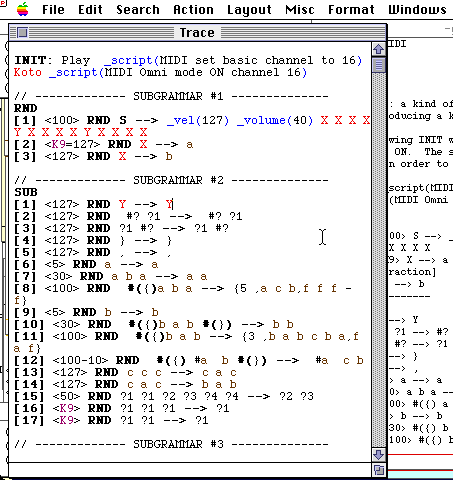 Fig.12 Tokenised grammar in "Trace"
window
Fig.12 Tokenised grammar in "Trace"
windowAll rules have been numbered and contain
weights. (See an explanation of weights in
reference manual §4.6) Rules that were not assigned explicit weights
appear with default weight <127>, a value that fits well with MIDI
parameters.
Also note that commentaries [between
square brackets] or lines starting with double slashes have been left out.
Rule numbering
has no real effect on computation. For instance, the order in which rules are
scanned in "ORD" grammars (see reference manual §4.4) is always
their actual order of occurrence in the grammar. Nevertheless, BP2 renumbers
subgrammars and rules at compile time. These numbers are used for conditional
jumps found in
grammar procedures (see §8.1 of reference
manual).
3.8 Checking grammar consistency
Selecting "Check variables" in
the "Search" menu produces a report on variables used in the grammar.
Some variables may be
undefined, i.e. they appear in the right argument of a rule and nowhere in the left argument of a grammar or glossary
rule. The grammar might therefore produce final strings containing these
variables. BP2 warns the user at compile time if the grammar contains undefined
variables. The grammar may nevertheless be used: when
interpreting the final string as a musical item, BP2 ignores left-over
variables. When compiling a glossary, however, an error message is returned if
any rule or "Define" instruction produced an undefined variable.
Conversely,
unreachable variables are the ones found in the
left argument of a rule although they appear in no right
argument, so that the grammar will never produce them. This is generally not
considered a mistake because a grammar may contain unreachable variables coming
from an earlier version. Rules containing them will never be candidates.
Glossaries may also contain many unreachable variables because a project is
generally not using all functionalities of MIDI devices -- it is not likely to
make use of the 128 instruments defined in General MIDI, for instance.
When compiling a glossary (see §7), BP2 makes sure that it does not generate
variables appearing in the left argument of a grammar rule. Since the glossary
is used only once all candidate rules in the grammar have been exhausted (or
there is no grammar), the grammar may not be invoked afterwards.
3.9 The start string
Select "Start string" in the "Windows" menu. A window appears
containing the string from which computation will start in production mode:
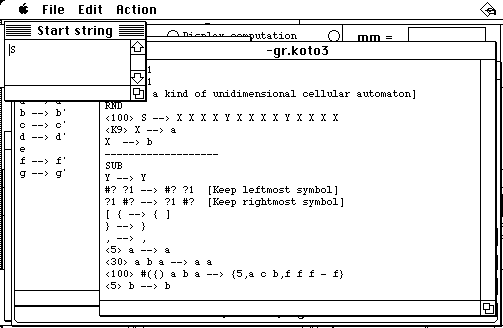 Fig.13
"Start string" window
Fig.13
"Start string" windowGenerally the start string is predefined symbol 'S', but sometimes you may want to
derive other strings of variables/terminal symbols, especially while debugging a
grammar. Type or paste start strings on separate lines in the "Start
string" window, then select the one you want by highlighting it with the
mouse. If you select no start string then the first one in the window is always
used. Since 'S' is already there whenever you start the program you may ignore
this "Start string" window until you decide to use alternate start
strings.
Start stringare stored in the "-se" settings file (see §16).
Another, more intuitive, way of using
any expression as a start string is to select it in any
window (including the grammar itself) and type cmd-p or select "Play
selection" in the "Action" window. Normally this command tries
to interpret the selection (using the alphabet), but if the selection contains
variables then it is taken as a start string and the grammar is prompted to
derive a
single item from it.








